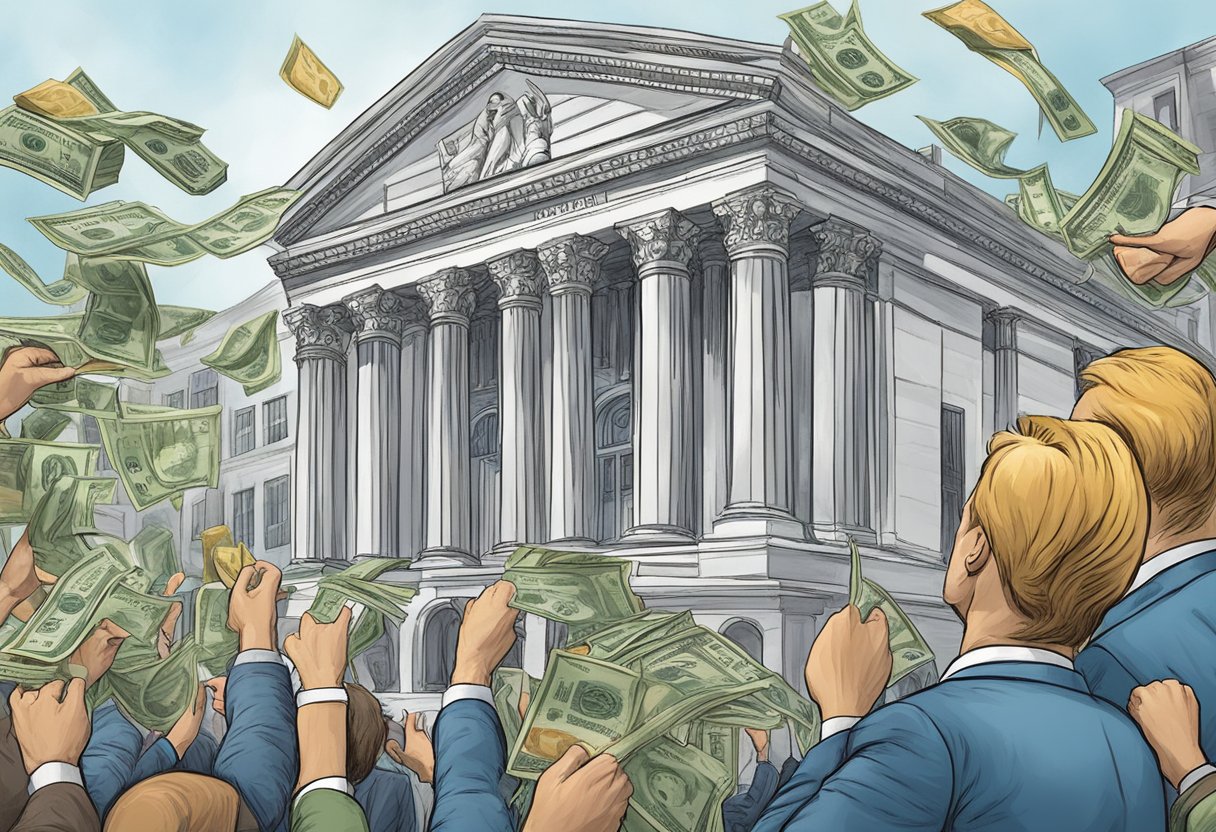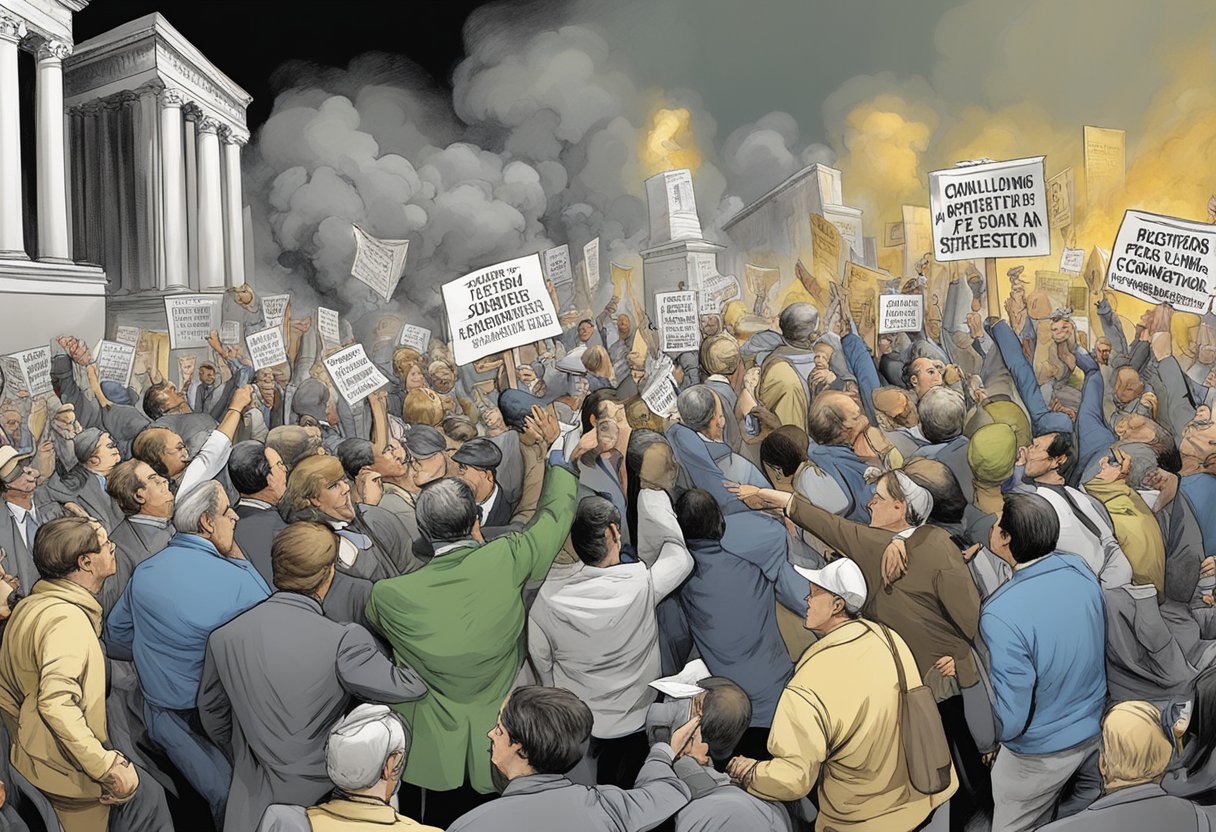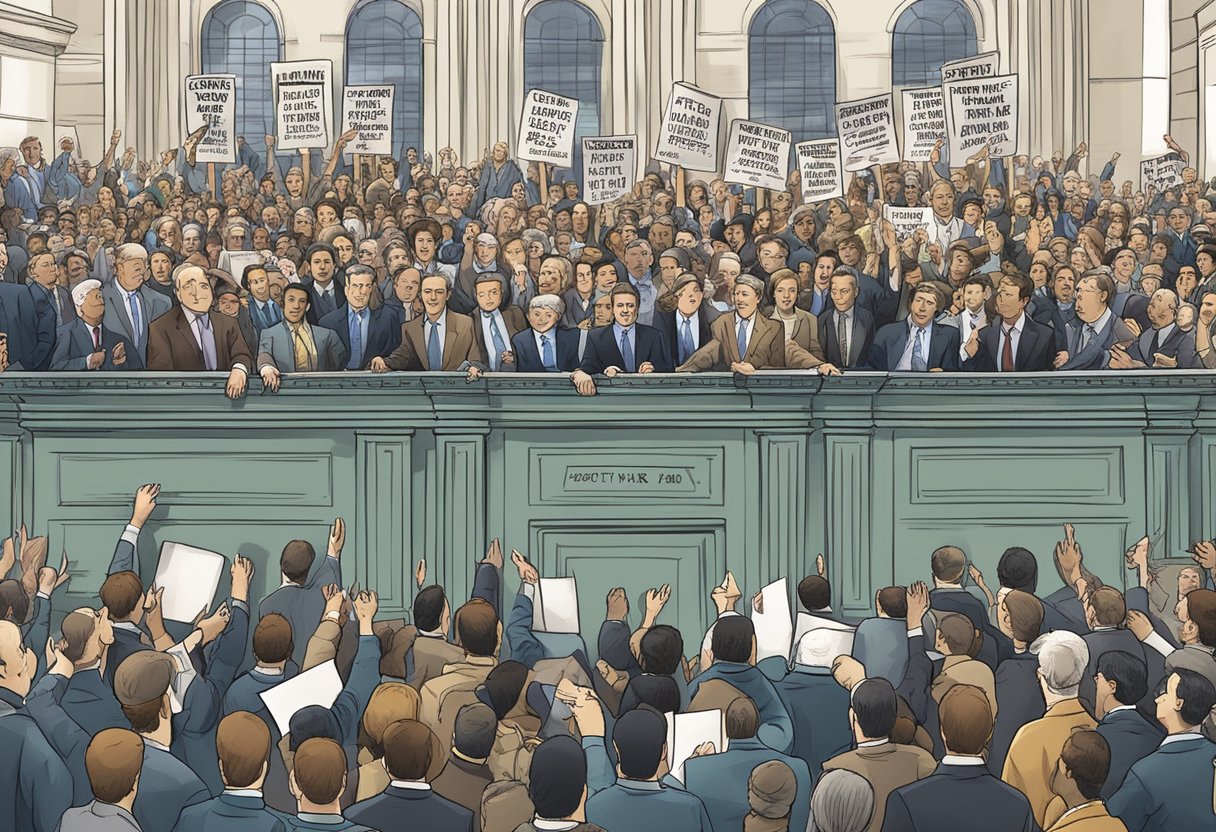The Dodd–Frank Wall Street Reform and Consumer Protection Act of 2010 stands as a significant piece of financial regulation in the United States. Enacted in response to the financial crisis of 2007-2008, the act aimed to decrease various risks in the financial system. It introduced rigorous supervision and governance on Wall Street, promising greater consumer protection and financial stability. Dodd-Frank empowered regulatory agencies to enforce its provisions, focusing on transparency and accountability for financial institutions.
Key components of the Dodd-Frank Act include the establishment of new government agencies tasked with implementing and enforcing compliance. The Consumer Financial Protection Bureau (CFPB) was created to protect consumers from predatory financial practices, and the Financial Stability Oversight Council (FSOC) was formed to identify risks to the financial stability of the United States. These agencies work along with the Securities and Exchange Commission (SEC) and the Commodity Futures Trading Commission (CFTC) to ensure that consumer protection and market integrity are at the forefront of financial regulation.
The act also introduces complex rules for systemic risk oversight and the management of large financial firms that are considered “too big to fail.” Under Dodd-Frank, these institutions are required to have plans for rapid and orderly resolution in the event of failure, without the need for taxpayer-funded bailouts. This framework is aimed at ending the practice of government bailouts and minimizing the risk of a future financial crisis caused by the collapse of large, interconnected financial entities.
Legislative Background
The Dodd–Frank Wall Street Reform and Consumer Protection Act represents a significant shift in American financial regulation following the 2008 financial crisis. This legislative effort aimed to reduce the risk of future financial crises and protect consumers from predatory financial practices.
Pre-Reform Financial Climate
Before the Dodd-Frank Act, the United States faced a severe financial crisis, which peaked in 2008 and led to a global recession. Inadequate financial regulation and risky banking practices contributed to a precarious economic environment, necessitating comprehensive reform. Financial instruments such as mortgage-backed securities were poorly understood, and their failure triggered an international banking emergency.
Key Legislative Figures
A number of prominent individuals played critical roles in the development of the Dodd-Frank Act. Democratic Congressman Barney Frank and Senator Chris Dodd were the act’s main architects. Their collaboration facilitated the House of Representatives’ passage of the bill. President Barack Obama endorsed the legislative framework and signed the Public Law 111-203. It is commonly known as the Dodd-Frank Act and was put into law on July 21, 2010. The Act responded to the financial crisis, signifying the Obama administration’s commitment to preventing a similar economic downturn.
Major Provisions
The Dodd–Frank Wall Street Reform and Consumer Protection Act of 2010 introduced significant changes to financial regulation in the United States with a focus on consumer protection, oversight of the financial system, and stringent regulation of financial markets.
Consumer Protection
The Consumer Financial Protection Bureau (CFPB) was established to enforce the Consumer Protection Act. It was also formed to oversee consumer financial products. Its creation aimed to prevent unfair, deceptive, or abusive practices and to ensure transparency in the financial marketplace. Key elements include the enforcement of the Truth in Lending Act and the integration of various consumer protection responsibilities previously scattered across different government agencies into the Bureau of Consumer Financial Protection.
Financial System Oversight
The Financial Stability Oversight Council (FSOC) was created to identify and monitor risks to the financial system, promoting systemic stability. It is authorized to designate systematically important financial institutions that could pose a significant risk to the financial system, ensuring that such entities are subject to enhanced oversight and prudential standards. Systemic Risk surveillance became a central mandate of the FSOC to prevent or mitigate threats to the stability of the financial system.
Regulation of Financial Markets
Critical to the regulation of financial markets was the introduction of the Volcker Rule, which limits proprietary trading activities by banks to curtail excessive risk-taking connected with these trades. The Dodd–Frank Act also amended existing legislation like the Commodity Exchange Act and the Securities Exchange Act of 1934, expanding the scope of regulation for key players in the financial markets. Enhanced transparency and stricter standards for derivatives trading were introduced to stabilize markets and protect market participants.
Impact on Financial Institutions

The Dodd-Frank Wall Street Reform and Consumer Protection Act brought significant changes to the financial industry. It particularly targets financial stability and capital structure in institutions deemed “too big to fail.”
Increased Capital Requirements
Under Dodd-Frank, banks and financial institutions are required to maintain higher levels of capital to protect against potential risks. Ensuring that in the event of financial distress, banks have sufficient capital reserves to last without receiving government bailouts. This has placed a more considerable emphasis on financial stability within the banking sector.
- Minimum capital ratios were raised, demanding a higher percentage of high-quality capital.
- Capital surcharges were introduced for systemically important financial institutions, known as SIFIs.
Restrictions on Banking Activities
Dodd-Frank imposed several restrictions on banking activities with the intent of reducing risky behaviors that contributed to the financial crisis.
- Volcker Rule: Prohibits banks from engaging in proprietary trading and from owning or sponsoring hedge funds and private equity funds.
- Restrictions on lenders engaging in certain types of trading and investment activities deemed risky.
Derivatives Market Reform
Significant reforms were introduced in the derivatives and swaps market to increase transparency and oversight.
- Swap dealers and major participants must now register with regulatory bodies and adhere to minimum standards for conduct.
- Mandated that over-the-counter derivatives, such as swaps, be transacted on regulated exchanges or cleared through central counterparties to mitigate systemic risk.
By enforcing these regulatory changes, Dodd-Frank has fundamentally reshaped the landscape for financial services. It demands that institutions increase resilience and decrease risk-taking behaviors.
Regulatory Framework
The Dodd–Frank Wall Street Reform and Consumer Protection Act reshaped the financial regulatory system in the United States. It assigns rigorous rulemaking and enforcement responsibilities to various federal agencies to ensure transparency and accountability in the financial sector.
Rulemaking and Enforcement
The Federal Government granted the Rulemaking Authority to several agencies. This led to the creation of final rules that dictate the operation of financial entities. The Federal Reserve plays a pivotal role in establishing rules for bank holding companies and other key financial institutions. Agencies must enforce compliance with these regulations to maintain systemic stability and consumer protection.
- Accountability: Financial institutions are held accountable through regulations designed to prevent malfeasance and systemic risk.
- Compliance: Entities like hedge funds and credit rating agencies are required to observe the established protocols to avoid punitive action.
Interagency Coordination
Agencies such as the Federal Deposit Insurance Corporation (FDIC) and the newly created Financial Stability Oversight Council work together to coordinate efforts across the government. Coordination ensures consistency in regulatory practice and the avoidance of regulatory gaps or overlaps.
- Coordination: Regular interagency meetings facilitate aligned policy enforcement.
- Final Rules: Collaboratively developed final rules clarify the responsibilities and limitations for all parties involved.
Oversight of Specific Areas
Specific areas of the financial system, such as hedge funds and credit rating agencies, now fall under closer scrutiny to mitigate systemic risk.
- Hedge Funds: They are required to register and report to the Securities and Exchange Commission, increasing transparency.
- Credit Rating Agencies: Subject to new levels of oversight aimed at ensuring the accuracy and reliability of their assessments.
Consumer Financial Protection Measures

The Dodd–Frank Wall Street Reform and Consumer Protection Act of 2010 introduced significant measures aimed at protecting consumers in financial markets. These measures include the creation of the Consumer Financial Protection Bureau (CFPB), substantial changes to mortgage lending practices, and enforcement of anti-discrimination laws in financial services.
Establishment of CFPB
The Consumer Financial Protection Bureau (CFPB) was established as an independent agency. It is primarily focused on protecting consumers in the financial sector. It oversees financial products and services, such as credit cards and payday loans, and it’s empowered to enforce federal consumer financial laws. The bureau is also tasked with educating consumers about their rights and financial options.
Mortgage Reforms and Lending Regulation
Regulatory changes under Dodd–Frank directly affected mortgage lending. These changes sought to curtail risky lending practices that contributed to the financial crisis and include:
- Assessment of Borrower’s Ability to Repay: Lenders must make a reasonable, good faith determination that the consumer has the ability to repay the loan.
- High-Cost Mortgage Protections: The Act imposed stricter regulations on high-cost mortgages, including limitations on prepayment penalties and fees.
- Mortgage Originator Standards: It introduced new standards for mortgage originators to prevent steering borrowers into higher-cost loans.
Protection Against Discrimination
Dodd–Frank reinforced legal prohibitions against discrimination in credit transactions. It was done by providing additional authority to the CFPB and imposing more stringent penalties for non-compliance. It aims to ensure all consumers have equal access to credit under:
- Equal Credit Opportunity Act (ECOA): Provisions were added to prevent lenders from engaging in discriminatory practices based on race, color, religion, nationality, sex, marital status, age, or receipt of public assistance.
- Centralized Complaint Tracking: Dodd–Frank instructed the CFPB to establish a unit dedicated to tracking consumer complaints regarding discrimination in the provision of financial services.
These measures reflect the Act’s commitment to safeguard consumers in their dealings with financial services and to promote fair and transparent operations within the finance industry.
Orderly Liquidation and Restructuring

The Dodd–Frank Wall Street Reform and Consumer Protection Act provides a framework to systematically wind down failing financial institutions in a manner designed to maintain financial stability and minimize impacts to economic growth.
Orderly Liquidation Authority (OLA)
The Orderly Liquidation Authority is a significant part of the Dodd–Frank Act created to address the failure of large, interconnected financial companies. In the event that a financial institution is deemed systematically important and its collapse could negatively impact financial stability, the OLA allows the federal government to take control of the failing entity to ensure its orderly liquidation. The process is overseen by the FDIC and aims to avoid the disruptive consequences of bankruptcy for large firms. Under this authority, the OLA facilitates:
- Appraisal of the firm’s assets and liabilities
- Transfer of operations to a bridge company if necessary
- Liquidation of the firm’s assets to pay creditors
The Orderly Liquidation Fund, established under Title II of the Dodd–Frank Act, provides the financial means to manage the dismantling of a failing firm. It enables the FDIC to make loans, purchase assets, or guarantee obligations to maintain business operations during the liquidation process.
TARP and Bailouts
The Troubled Asset Relief Program (TARP), established during the 2008 financial crisis, allowed the government to purchase or insure “troubled assets” to stabilize the market. Dodd–Frank aimed to restrict the potential for future bailouts by imposing stricter regulations and oversight. It fundamentally alters how bailouts are handled. The act’s provisions discourage excessive risk-taking and ensure that shareholders and unsecured creditors bear losses, not taxpayers. Specifically, the Act:
- Mandates plans for rapid and orderly resolution under bankruptcy laws
- Limits the ability of firms to become “too big to fail” and rely on government rescues
In essence, Dodd–Frank’s approach to TARP and bailouts places the onus on the financial institutions to have their own wind-down plans, known as “living wills”, to prevent extensive bailouts and to ensure that any rescue does not undermine the overall stability and growth of the economy.
Long-Term Effects and Controversies

The Dodd–Frank Wall Street Reform and Consumer Protection Act has elicited ongoing debates about its long-term effects on financial regulation and economic growth while inspiring various legislative amendments.
Financial Industry Response
The financial industry has had a dynamic response to the Dodd-Frank Act since its enactment. Initially, financial institutions faced increased costs associated with compliance, leading to restructuring efforts aimed at maintaining profitability. For instance, banks adapted by increasing their capital reserves to meet the stringent requirements set by the Federal Reserve Board. On the other side, some small community banks argued that the costs and bureaucratic complexities put them at a disadvantage compared to larger banks.
Amendments and Proposals
Over time, the Dodd-Frank Act has seen various amendments and proposals aimed at refining the initial legislation. A notable amendment is the Economic Growth, Regulatory Relief, and Consumer Protection Act of 2018. Which was aimed at easing some of the regulatory pressures for smaller banks. This was in part a response to concerns that the Dodd-Frank Act may have inadvertently stifled economic growth by imposing one-size-fits-all regulations. Proposals for future amendments continue to reflect a balancing act between protecting consumers and the markets and promoting economic growth.
Critical Perspectives
Critics of the Dodd-Frank Act have questioned its impact on financial reform and corporate governance. Some argue that it has led to excessive bureaucracy, which has hindered financial markets and economic growth. Conversely, proponents assert that the legislation has enhanced the stability of the financial system. Controversies remain over the effectiveness of specific provisions, such as the Volcker Rule, which restricts banks from certain speculative investments. The ongoing discourse reflects a fundamental tension within financial regulation between market freedom and the need to safeguard against systemic risks.
Conclusion

The Dodd-Frank Wall Street Reform and Consumer Protection Act of 2010 emerged as a landmark piece of legislation aimed at addressing the systemic issues that led to the 2008 financial crisis. This comprehensive reform package ushered in a new era of financial oversight and accountability, introducing measures to enhance transparency, regulate financial institutions, and protect consumers. While the Dodd-Frank Act faced criticism for its complexity and regulatory burden, its overarching goal was to foster a more resilient and stable financial system. Over the years, its impact has been significant, contributing to a more transparent and accountable financial landscape that seeks to prevent the excesses and failures that precipitated the economic downturn. The legacy of the Dodd-Frank Act continues to shape the financial regulatory framework, sparking ongoing debates about the balance between regulation and market innovation in the quest for a secure and sustainable financial future.
